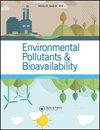Mixed-ligand complex formation equilibria of vanadium(III) with picolinic and dipicolinic acids with some dicarboxylic acids (oxalic, malonic, and phthalic acids) studied in 3.0 M KCl at 25 °C
Q3 Chemical Engineering
引用次数: 2
Abstract
The ternary complexes formed between vanadium(III) and picolinic acid (Hpic) and dipicolinic acid (H2dipic) with the dicarboxylic oxalic, malonic, and phthalic acids (H2ox), (H2mal), and (H2phtha) briefly (H2L) were studied in aqueous solution by means of electromotive forces’ measurements emf(H) at 25 °C and 3.0 mol dm−3 KCl as ionic medium. The potentiometric data were analyzed using the least-squares computational program LETAGROP, considering the hydrolysis products of the V(III), the acidity constants of the ligands employed, and the formation constants of the binary complexes, obtaining the complexes V(pic)(ox), log β1,1,1,−3 = 5.39(7) and [V(pic)2(ox)]−, log β1,2,1,−4 = 4.3(1); V(pic)(ma), log β1,1,1,−3 = 5.58(5) and [V(pic)2(ox)]−, log β1,2,1,−4 = 5.00(8); V(pic)(phtha), log β1,1,1,−3 = 5.66(6) and [V(pic)2(phtha)]− log β1,2,1,−4 = 4.5(2) in the vanadium(III)-Hpic-H2L system. In the case of the vanadium(III)-H2dipic-H2L system, the complexes [V(dipic)(ox)]−, log1,1,1,−4 β = 9.3(2), [V(dipic)(Hox)(ox)]2−, log β1,1,2,−5 = 11.2(2) and [V(dipic)(ox)2]3−, log β1,1,2,.6 = 5.7 max 7.0; [V(dipic)(ma)]−, log β1,1,1,−4 = 8.7(2), [V(dipic)(Hma)(ma)]2−, log β1,1,2,−5 = 10.3(1) and [V(dipic)(ma)2]3−, log β1,1,2,.6 = 6.9(1); [V(dipic)(phtha)]−, log β1,1,1,−4 = 10.9(1), [V(dipic)(Hphtha)(phtha)]2−, log β1,1,2,−5 = 9.2 max 10.4 and [V(dipic)(phtha)2]3−, log β1,1,2,.6 = 6.9(3) were observed.研究了钒(III)与吡啶酸、二吡啶酸和某些二羧酸(草酸、丙二酸和邻苯二甲酸)在3.0 M KCl中25°C的混合配体络合物形成平衡
用电动势测量法研究了钒(III)与吡啶酸(Hpic)和二吡啶酸(H2dipic)在水溶液中与二羧酸草酸、丙二酸和邻苯二酸(H2ox)、(H2mal)和(H2phtha) (H2L)在25℃、3.0 mol dm−3 KCl为离子介质时形成的三元配合物。利用最小二乘计算程序LETAGROP对电位数据进行分析,考虑V(III)的水解产物、配体的酸度常数和二元配合物的形成常数,得到配合物V(pic)(ox), log β1,1,1,−3 = 5.39(7)和[V(pic)2(ox)]−,log β1,2,1,−4 = 4.3(1);V (pic) (ma)、日志β1,1,1,−3 = 5.58(5)和(V (pic) 2(牛))−,日志β1、2、1,−4 = 5.00 (8);在钒(III)-Hpic-H2L体系中,V(pic)(phtha), log β1,1,1,−3 = 5.66(6)和[V(pic)2(phtha)] - log β1,2,1,−4 = 4.5(2)在钒(III)-H2dipic-H2L体系中,配合物[V(dipic)(ox)]−,log1,1,1,−4 β = 9.3(2), [V(dipic)(Hox)(ox)]2−,log β1,1,2,−5 = 11.2(2)和[V(dipic)(ox)2]3−,log β1,1,2,。6 = 5.7 Max 7.0;[V (dipic) (ma)]−,日志β1,1,1,−4 = 8.7 (2),(V (dipic)(协会)(ma)] 2−日志β1,1,2,−5 = 10.3(1)和(V (dipic) (ma) 2) 3−日志β1,1,2,。6 = 6.9(1);[V (dipic) (phtha)]−,日志β1,1,1,−4 = 10.9 (1),(V (dipic) (Hphtha) (phtha)] 2−日志β1,1,2,−5 = 9.2最大10.4和[V (dipic) (phtha) 2] 3−日志β1,1,2,。6 = 6.9(3)例。
本文章由计算机程序翻译,如有差异,请以英文原文为准。
求助全文
约1分钟内获得全文
求助全文
来源期刊
CiteScore
1.62
自引率
0.00%
发文量
0
审稿时长
1 months
期刊介绍:
Chemical Speciation & Bioavailability ( CS&B) is a scholarly, peer-reviewed forum for insights on the chemical aspects of occurrence, distribution, transport, transformation, transfer, fate, and effects of substances in the environment and biota, and their impacts on the uptake of the substances by living organisms. Substances of interests include both beneficial and toxic ones, especially nutrients, heavy metals, persistent organic pollutants, and emerging contaminants, such as engineered nanomaterials, as well as pharmaceuticals and personal-care products as pollutants. It is the aim of this Journal to develop an international community of experienced colleagues to promote the research, discussion, review, and spread of information on chemical speciation and bioavailability, which is a topic of interest to researchers in many disciplines, including environmental, chemical, biological, food, medical, toxicology, and health sciences.
Key themes in the scope of the Journal include, but are not limited to, the following “6Ms”:
Methods for speciation analysis and the evaluation of bioavailability, especially the development, validation, and application of novel methods and techniques.
Media that sustain the processes of release, distribution, transformation, and transfer of chemical speciation; of particular interest are emerging contaminants, such as engineered nanomaterials, pharmaceuticals, and personal-care products.
Mobility of substance species in environment and biota, either spatially or temporally.
Matters that influence the chemical speciation and bioavailability, mainly environmentally relevant conditions.
Mechanisms that govern the transport, transformation, transfer, and fate of chemical speciation in the environment, and the biouptake of substances.
Models for the simulation of chemical speciation and bioavailability, and for the prediction of toxicity.
Chemical Speciation & Bioavailability is a fully open access journal. This means all submitted articles will, if accepted, be available for anyone to read, anywhere, at any time. immediately on publication. There are no charges for submission to this journal.

 求助内容:
求助内容: 应助结果提醒方式:
应助结果提醒方式:


